|
GIANT
SQUID
ABOUT -
HOME - WHALING - A-Z INDEX
Anchovies
| Bass
| Bream
| Catfish
| Clams
| Cod
Coley
| Crabs
| Crayfish
| Eels
| Grouper
| Haddock
| Hake
| Halibut
| Herring
| Jellyfish
Krill
| Lobster
| Mackerel
| Marlin
| Monkfish
| Mullet
| Mussels
| Oysters
| Perch
| Piranha |
Plaice
| Pollock
| Prawns
| Rays
| Sablefish
| Salmon
Sardines
| Scallops
| Sharks
| Shrimp
| Skate
| Sole
| Sprat
| Squid
| Sturgeon
| Swordfish
| Trout
| Tuna
| Turbot
| Whiting
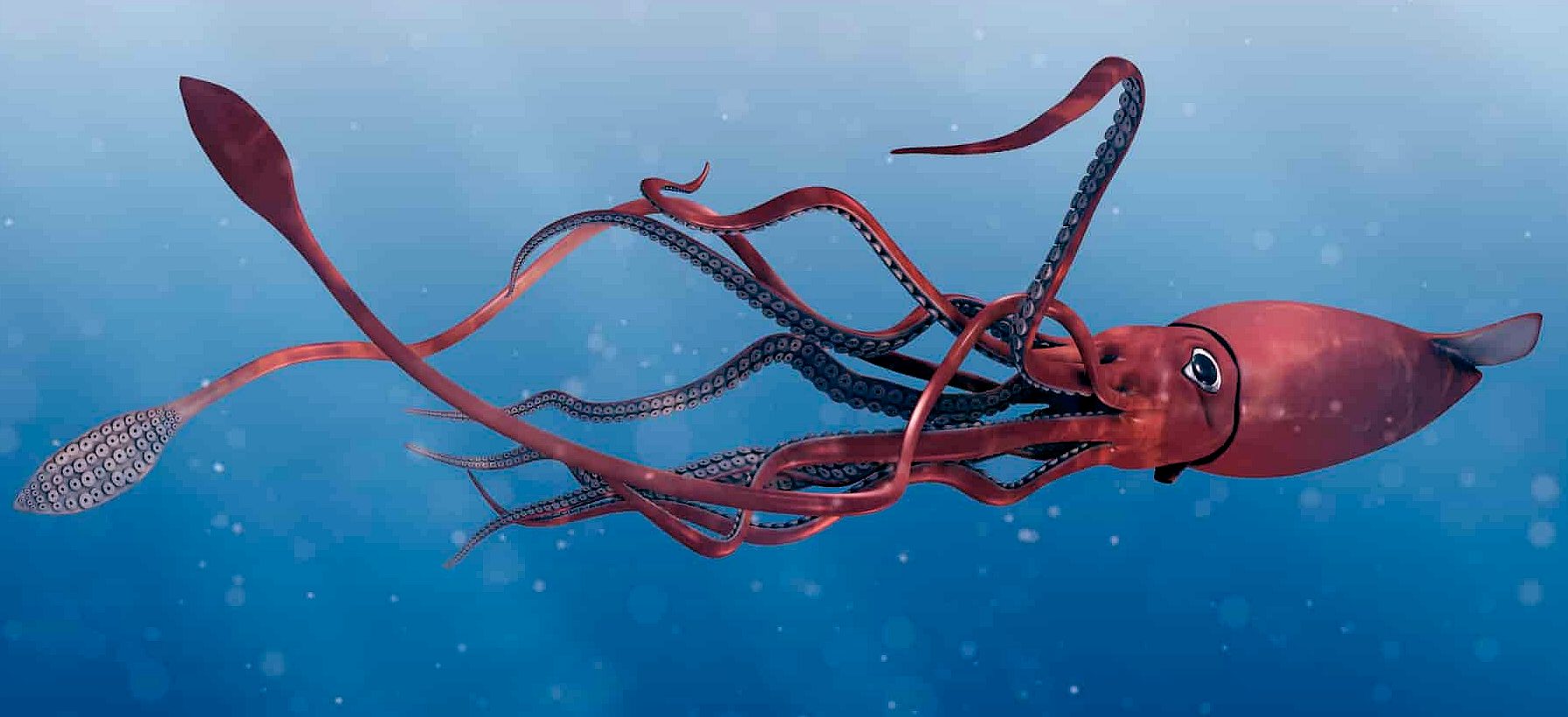
SQUID -
Not only popular with sperm whales, squid is eaten by humans,
as one of the ingredients of many delicious seafood dishes,
but not the giant that roams the deeps.
The
villain in many a good movie, the giant squid has sent a
shudder down the spines of children watching the likes of
Jules Verne's 20,000
Leagues Under the Sea and as the kraken (giant octopus
variant) in Disney's Pirates of the
Caribbean.
Squid are cephalopods of the order Teuthida. They are the sister group to the octopods. Squid are carnivores and, in turn, they are hunted. The largest squid, the giant squid and colossal squid, are eaten by
sperm whales and sleeper
sharks.
The giant squid (genus Architeuthis) is a deep-ocean dwelling squid in the family Architeuthidae. Giant squid can grow to a tremendous size due to deep-sea gigantism: recent estimates put the maximum size at 13 m (43 ft) for females and 10 m (33 ft) for males from the posterior fins to the tip of the two long tentacles (second only to the colossal squid at an estimated 14 m (46 ft), one of the largest living organisms). The mantle is about 2 m (6 ft 7 in) long (more for females, less for males), and the length of the squid excluding its tentacles (but including head and arms) rarely exceeds 5 m (16 ft). Claims of specimens measuring 20 m (66 ft) or more have not been scientifically documented.
The number of different giant squid species has been debated, but recent genetic research suggests that only one species exists.
In 2004, Japanese researchers took the first images of a live giant squid in its natural habitat, and in July 2012, a live adult was first filmed in its natural habitat off
Chichijima.
The giant squid is the second-largest mollusc and one of the largest of all extant invertebrates. It is only exceeded by the colossal squid, Mesonychoteuthis hamiltoni, which may have a mantle nearly twice as long. Several extinct cephalopods, such as the Cretaceous vampyromorphid Tusoteuthis, the Cretaceous coleoid Yezoteuthis, and the Ordovician nautiloid Cameroceras may have grown even larger.
Giant squid size, particularly total length, has often been exaggerated. Reports of specimens reaching and even exceeding 20 m (66 ft) are widespread, but no specimens approaching this size have been scientifically documented. According to giant squid expert Steve O'Shea, such lengths were likely achieved by greatly stretching the two tentacles like elastic bands.
Based on the examination of 130 specimens and of beaks found inside sperm whales, giant squids' mantles are not known to exceed 2.25 m (7 ft 4.6 in). Including the head and arms, but excluding the tentacles, the length very rarely exceeds 5 m (16 ft). Maximum total length, when measured relaxed post mortem, is estimated at 13 m (43 ft) for females and 10 m (33 ft) for males from the posterior fins to the tip of the two long tentacles.
Giant squid exhibit sexual dimorphism. Maximum weight is estimated at 275 kg (606 lb) for females and 150 kg (330 lb) for males.
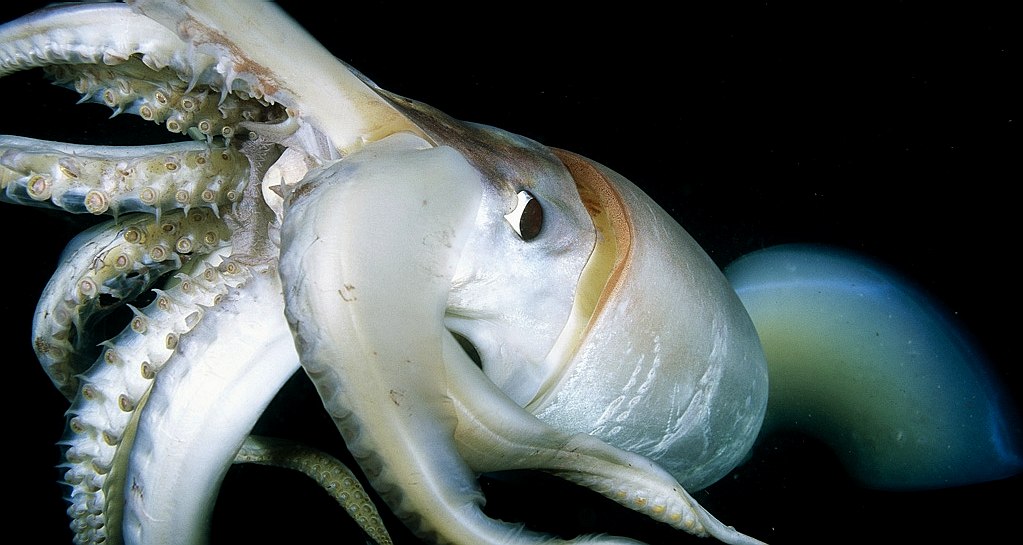
ANATOMY
Like all squid, a giant squid has a mantle (torso), eight arms, and two longer tentacles (the longest known tentacles of any cephalopod). The arms and tentacles account for much of the squid's great length, making it much lighter than its chief predator, the sperm whale. Scientifically documented specimens have masses of hundreds, rather than thousands, of kilograms (100 kg is approximately 220 lb).
The inside surfaces of the arms and tentacles are lined with hundreds of subspherical suction cups, 2 to 5 cm (0.79 to 1.97 in) in diameter, each mounted on a stalk. The circumference of these suckers is lined with sharp, finely serrated rings of
chitin. The perforation of these teeth and the suction of the cups serve to attach the squid to its prey. It is common to find circular scars from the suckers on or close to the head of sperm whales that have attacked giant squid.
Each tentacular club is divided into three regions - the carpus ("wrist"), manus ("hand") and dactylus ("finger"). The carpus has a dense cluster of cups, in six or seven irregular, transverse rows. The manus is broader, closer to the end of the club, and has enlarged suckers in two medial rows. The dactylus is the tip. The bases of all the arms and tentacles are arranged in a circle surrounding the animal's single, parrot-like beak, as in other cephalopods.
Giant squid have small fins at the rear of their mantles used for locomotion. Like other cephalopods, they are propelled by jet—by pulling water into the mantle cavity, and pushing it through the siphon, in gentle, rhythmic pulses. They can also move quickly by expanding the cavity to fill it with
water, then contracting muscles to jet water through the siphon. Giant squid breathe using two large gills inside the mantle cavity. The circulatory system is closed, which is a distinct characteristic of cephalopods. Like other squid, they contain dark ink used to deter predators.
The giant squid has a sophisticated nervous system and complex brain, attracting great interest from scientists. It also has the largest eyes of any living creature except perhaps the colossal
squid - up to at least 27 cm (11 in) in diameter, with a 9 cm (3.5 in) pupil (only the extinct ichthyosaurs are known to have had larger eyes). Large eyes can better detect light (including bioluminescent light), which is scarce in deep water. The giant squid probably cannot see colour, but it can probably discern small differences in tone, which is important in the low-light conditions of the deep
ocean.
Giant squid and some other large squid species maintain neutral buoyancy in seawater through an ammonium chloride solution which is found throughout their bodies and is lighter than seawater. This differs from the method of flotation used by most fish, which involves a gas-filled swim bladder. The solution tastes somewhat like salmiakki and makes giant squid unattractive for general human consumption.
Like all cephalopods, giant squid use organs called statocysts to sense their orientation and motion in water. The age of a giant squid can be determined by "growth rings" in the statocyst's statolith, similar to determining the age of a tree by counting its rings. Much of what is known about giant squid age is based on estimates of the growth rings and from undigested beaks found in the stomachs of sperm whales.
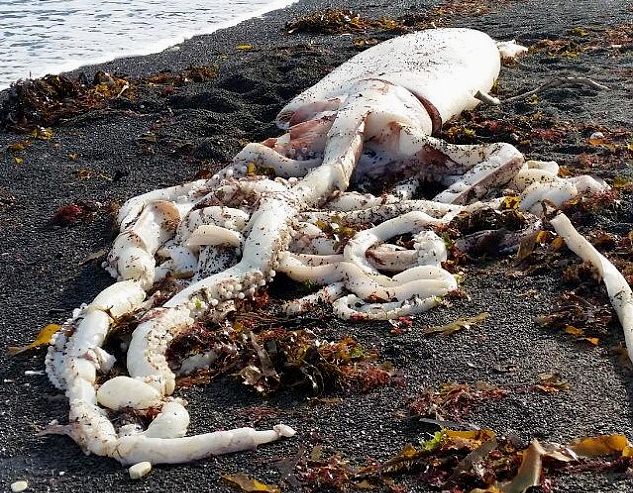
DNA
Analysis of the mitochondrial DNA of giant squid individuals from all over the world has found that there is little variation between individuals across the globe (just 181 differing genetic base pairs out of 20,331). This suggests that there is but a single species of giant squid in the world. Squid larvae may be dispersed by ocean currents across vast distances.
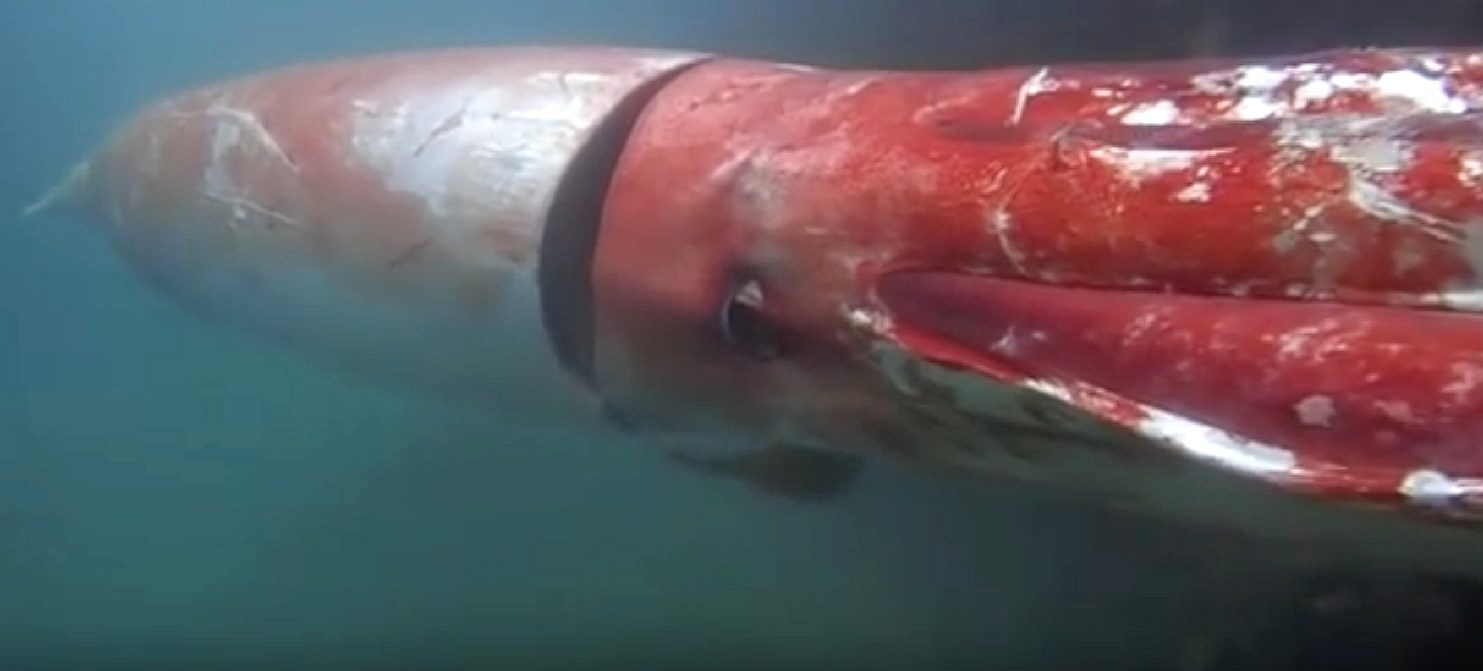
HABITAT
Giant squid are widespread, occurring in all of the world's oceans. They are usually found near continental and island slopes from the North Atlantic
Ocean, especially Newfoundland,
Norway, the northern British Isles,
Spain and the oceanic islands of the Azores and Madeira, to the South
Atlantic around southern
Africa, the North Pacific around
Japan, and the southwestern
Pacific around New Zealand and
Australia. Specimens are rare in tropical and polar latitudes.
The vertical distribution of giant squid is incompletely known, but data from trawled specimens and
sperm whale diving behaviour suggest it spans a large range of depths, possibly 300–1,000 metres (980–3,280 ft).
REPRODUCTION
Little is known about the reproductive cycle of giant squid. They are thought to reach sexual maturity at about three years old; males reach sexual maturity at a smaller size than females. Females produce large quantities of eggs, sometimes more than 5 kg (11 lb), that average 0.5 to 1.4 mm (0.020 to 0.055 in) long and 0.3 to 0.7 mm (0.012 to 0.028 in) wide. Females have a single median ovary in the rear end of the mantle cavity and paired, convoluted oviducts, where mature eggs pass exiting through the oviducal glands, then through the nidamental glands. As in other squid, these glands produce a gelatinous material used to keep the eggs together once they are laid.
In males, as with most other cephalopods, the single, posterior testis produces sperm that move into a complex system of glands that manufacture the spermatophores. These are stored in the elongate sac, or Needham's sac, that terminates in the penis from which they are expelled during mating. The penis is prehensile, over 90 cm (35 in) long, and extends from inside the mantle.
How the sperm is transferred to the egg mass is much debated, as giant squid lack the hectocotylus used for reproduction in many other cephalopods. It may be transferred in sacs of spermatophores, called spermatangia, which the male injects into the female's arms. This is suggested by a female specimen recently found in Tasmania, having a small subsidiary tendril attached to the base of each arm.
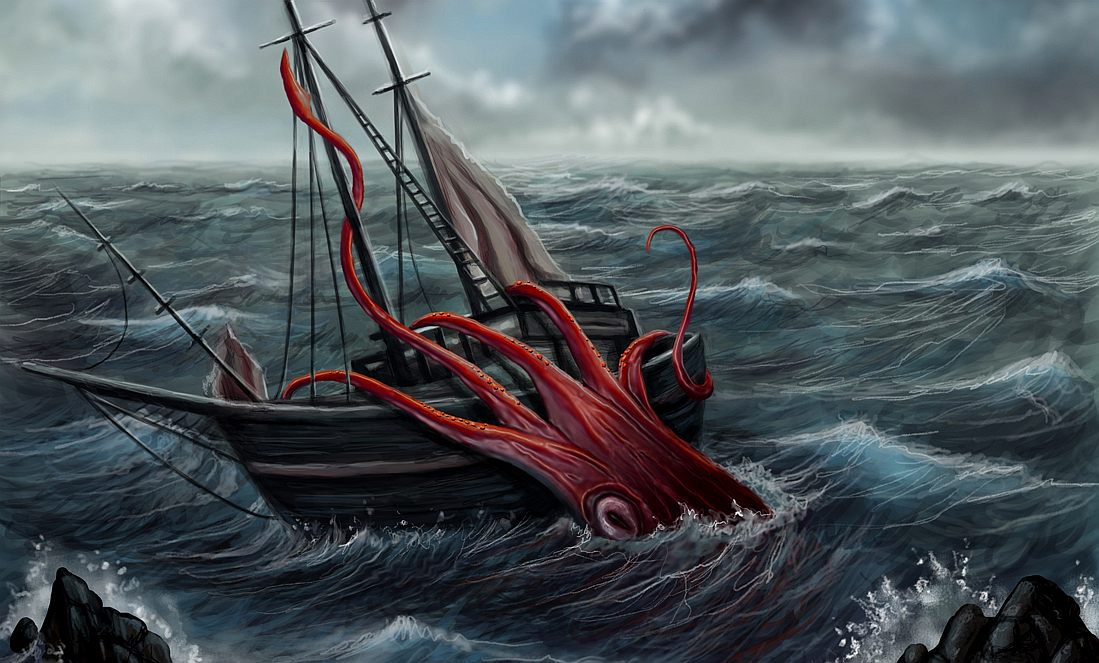
KRAKEN
The kraken is a legendary cephalopod-like sea monster of giant size that is said to dwell off the coasts of Norway and Greenland. Authors over the years have postulated that the legend originated from sightings of giant squids
morphed with octopus. The sheer size and fearsome appearance attributed to the kraken have made it a common ocean-dwelling monster in various fictional works.
Since the late 18th century, kraken have been depicted in a number of ways, primarily as large octopus-like creatures, and it has often been alleged that Pontoppidan's kraken might have been based on sailors' observations of the giant squid. The kraken is also depicted to have spikes on its suckers. In the earliest descriptions, however, the creatures were more crab-like than octopus-like, and generally possessed traits that are associated with large whales rather than with giant squid. Some traits of kraken resemble undersea volcanic activity occurring in the Iceland region, including bubbles of water; sudden, dangerous currents; and appearance of new islets.
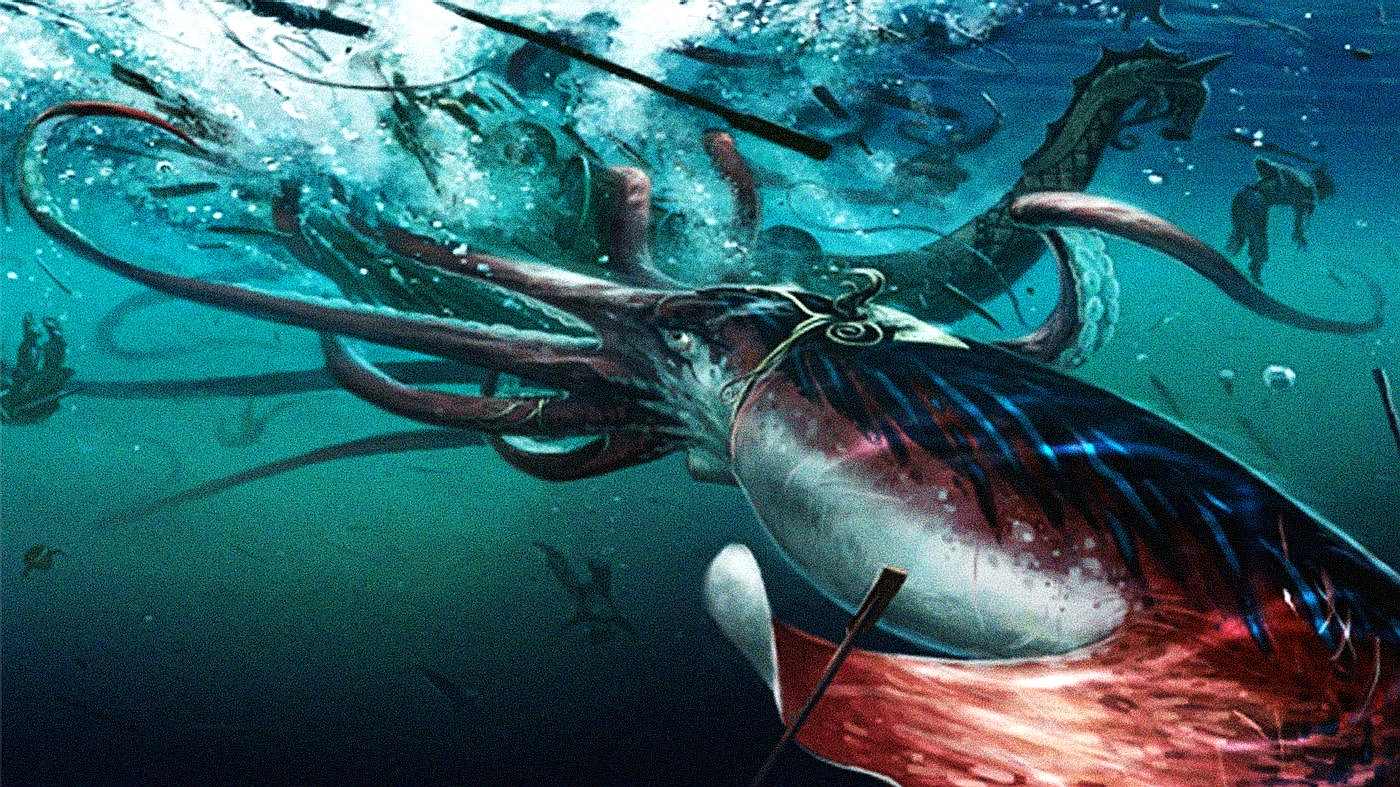
In
Herman
Melville's 1851 novel Moby-Dick (Chapter 59. Squid.) the Pequod encounters what chief mate Starbuck identifies as: "The great live squid, which, they say, few whale-ships ever beheld, and returned to their ports to tell of it." Narrator Ishmael adds: "There seems some ground to imagine that the great Kraken of Bishop Pontoppodan
may ultimately resolve itself into Squid." He concludes the chapter by adding: "By some naturalists who have vaguely heard rumors of the mysterious creature, here spoken of, it is included among the class of cuttle-fish, to which, indeed, in certain external respects it would seem to belong, but only as the Anak of the tribe."
Pontoppidan's description influenced Jules
Verne's depiction of the famous giant squid in Twenty Thousand Leagues Under the Sea from 1870.
John Wyndham's apocalyptic science fiction novel The Kraken Wakes depicts humanity locked in an existential struggle with ocean-dwelling aliens.
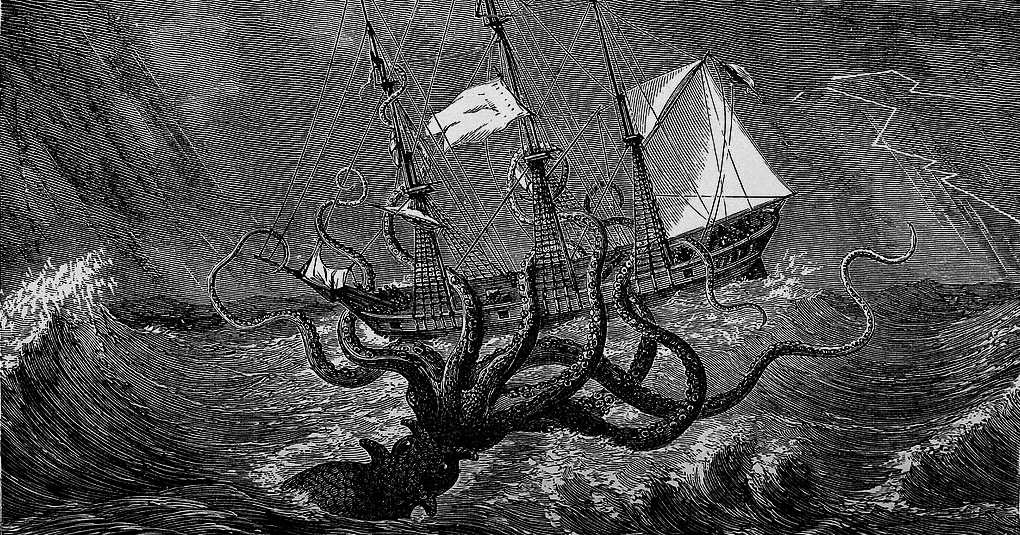
FOOD
SECURITY
In
an effort to feed
a
growing population we
should look at alternatives lower down the food chain to
increase the ratio at which protein is harvested from the ocean,
so bypassing the conventional losses in the conversion process
from phytoplankton to zooplankton
and so on. Squid could play a part in filling the widening gap
between falling fish
stocks and higher demand to feed humans.
LINKS
& REFERENCE
https://
http://www.dailymail.co.uk/sciencetech/article-3172352/Monstrous-GIANT-SQUID-caught-camera-Russian-fishermen-desperately-try-save-catch-terror-deep.html
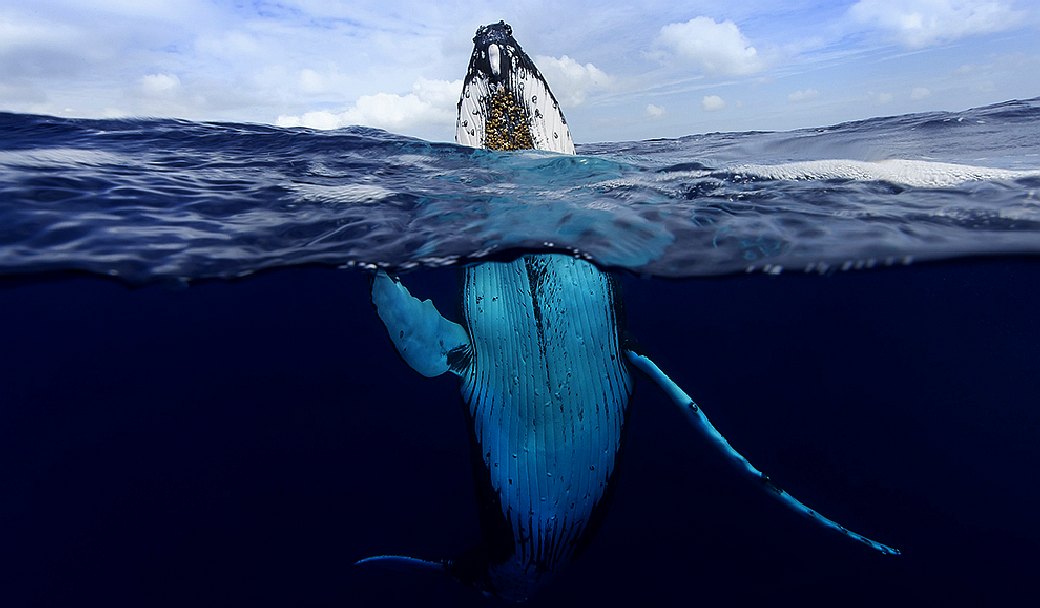
MARINE
LIFE - This humpback whale is one example of a magnificent
animal that is at the mercy of human
activity. Humans are for the most part unaware of the harm their fast-lane
lifestyles are causing. We aim to change that by doing all we
can to promote ocean
literacy.
Anchovies
| Bass
| Bream
| Catfish
| Clams
| Cod
Coley
| Crabs
| Crayfish
| Eels
| Grouper
| Haddock
| Hake
| Halibut
| Herring
| Jellyfish
Krill
| Lobster
| Mackerel
| Marlin
| Monkfish
| Mullet
| Mussels
| Oysters
| Perch
| Plaice
| Pollock
| Prawns
| Rays
| Sablefish
| Salmon
Sardines
| Scallops
| Sharks
| Shrimp
| Skate
| Sole
| Sprat
| Squid
| Sturgeon
| Swordfish
| Trout
| Tuna
| Turbot
| Whiting
This
website is provided on a free basis as a public information
service. Copyright © Cleaner
Oceans Foundation Ltd (COFL) (Company No: 4674774)
2022. Solar
Studios, BN271RF, United Kingdom.
COFL
is a charity without share capital.
|







